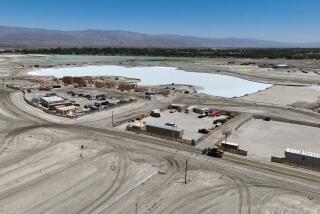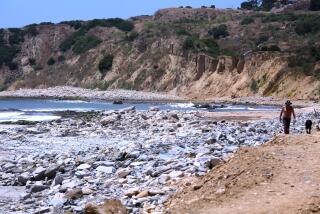Developer Offers to Expand Wetlands if 4,884 Homes Get OK
- Share via
HUNTINGTON BEACH — Bolsa Chica, Southern California’s largest wetlands, would be tripled in exchange for government permission to build 4,884 homes around the perimeter under a plan unveiled by the would-be developers Wednesday.
Although a coalition of local citizen groups charged that the number of new houses would overwhelm the ecologically delicate area, Koll Co. officials said their development would not harm the birds or wildlife in the wetlands.
“Not only will the plan not hurt the Bolsa Chica, this plan calls for enhancing and enlarging the wetlands,” said Lucy Dunn, a senior vice president of the Koll Co. “The plan calls for restoring severely degraded existing wetlands and creating new wetlands. It will be something for not only this community, but the whole nation, to be proud of.”
But Ralph Bauer, a spokesman for CoOp, a coalition of 15 homeowner and other citizen groups, said 4,884 new homes would be excessive.
“We think any development should be restricted to the higher ground, the Bolsa Chica Mesa area, which contains about 245 acres,” Bauer said. “We think there should only be four homes per acre.” Thus, Bauer added, the coalition believes development should be limited to 980 new residences.
The plan, made public Wednesday, would expand the wetlands to about 1,100 acres from the 300 acres owned and protected by the state. But it has many hurdles to pass before any house can be built.
The plan must pass an environmental impact study and review by the Huntington Beach Planning Commission and City Council. While Bolsa Chica is currently outside the city limits, Huntington Beach is in the process of annexing it from Orange County.
Bolsa Chica, which means “little pocket” in Spanish, is a natural coastal salt marsh between Seal Beach and Huntington Beach. The marsh originally covered 2,300 acres before settlers moved in and started draining the land at the turn of the century. Today only about 300 acres of the wetlands are state-owned and protected for wildlife use.
In the last 20 years, environmentalists have fought vigorous battles to keep creeping suburban development from taking what is left of Bolsa Chica. About 10 years ago, Orange County developers were on the verge of success in an attempt to make the marshland into a posh new marina, adjoining the existing Huntington Harbour.
But the environmental group Amigos de Bolsa Chica succeeded in getting the marina plan killed. Two years ago, the Amigos and representatives of the major landowner, Signal Landmark, hammered out a compromise that also had the approval of state, county and Huntington Beach governments. The compromise called for allowing some housing development of lands around Bolsa Chica in exchange for the donation of a substantial amount of acreage for wetlands use.
Signal Landmark is a subsidiary of Henley Properties, which last year hired the Newport Beach-based Koll Co. to handle the Bolsa Chica development plans.
The multi-government compromise of 1989 called for up to 5,700 houses to be built on land around the Bolsa Chica. Koll’s plan presented Wednesday represents a reduction of about 900 houses.
The Koll Co. plans call for expanding the existing wetlands by having a new channel cut under Pacific Coast Highway, linking ocean water to the marsh. A large new lagoon would be formed just east of the existing wetlands, according to the plan.
The plan also calls for the development company to donate about 50 additional acres of non-wetlands property to Orange County for a proposed regional park adjoining Bolsa Chica. The proposed park, long in the planning stage, is called the Linear Regional Park. The new regional park would link Huntington Beach’s existing Central Park to the ocean by a narrow strip of land.
Koll officials said that if the plan passes all governmental hurdles, construction of houses will start in 1994.
More to Read
Sign up for Essential California
The most important California stories and recommendations in your inbox every morning.
You may occasionally receive promotional content from the Los Angeles Times.










